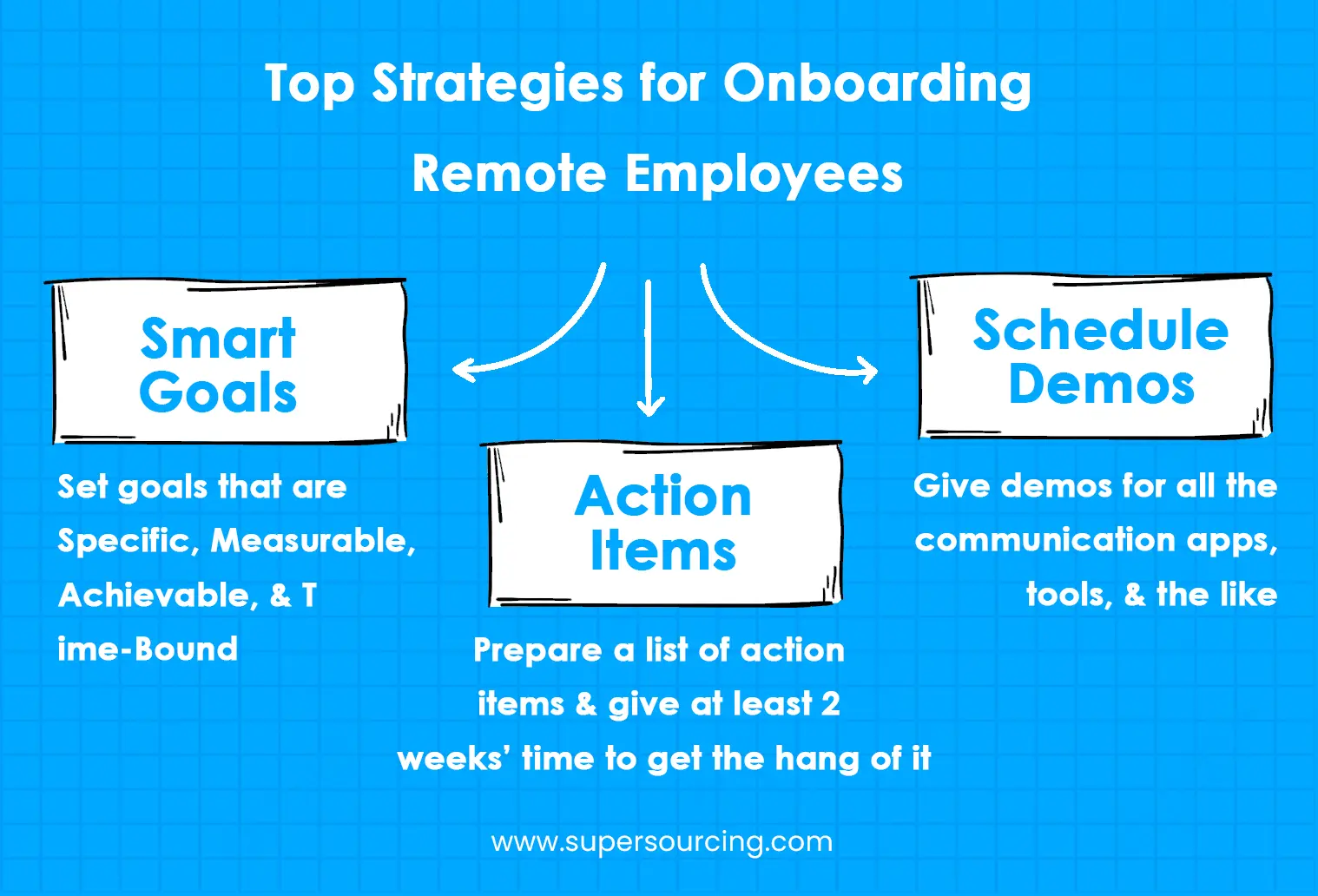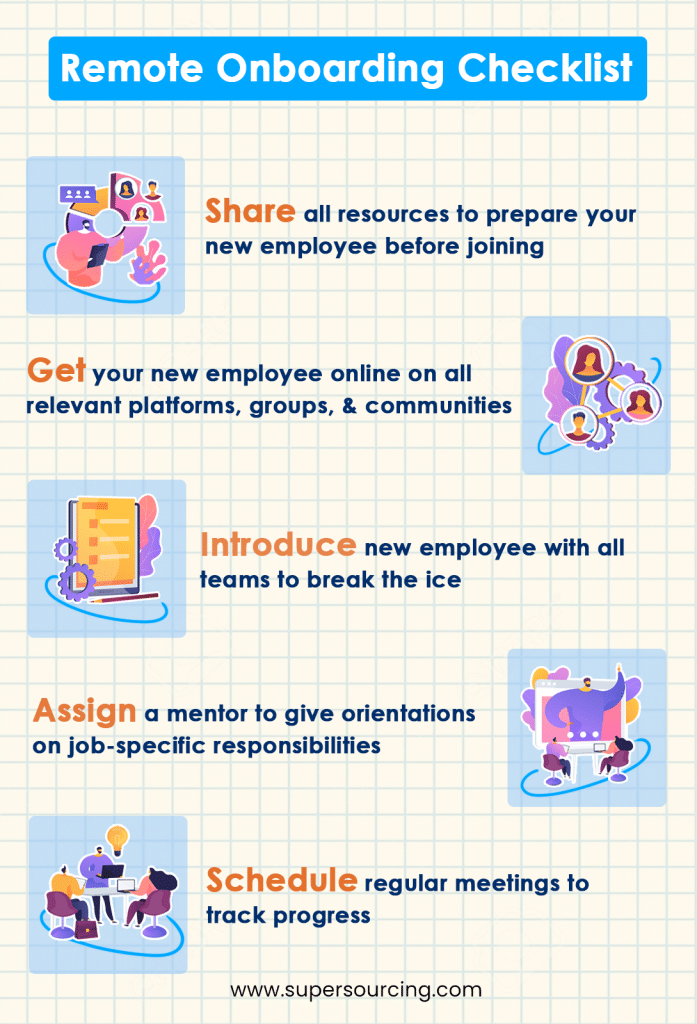Table of content
Onboarding is super important when it comes to setting your employees up for success, especially when you are hiring remotely. If you get it right, it can create a lot of positive momentum for your new hire. However, if you get it wrong, it can really break their confidence. It can make the organization question whether they made the right decision in hiring and onboarding remote employees.The thing that sets companies apart when it comes to onboarding, whether it’s in-person or virtual, is that they approach it intentionally and see it as an ongoing process. It doesn’t just end after the first week or 30 days or even 100 days. Instead, it should be the start of a developmental foundation that continues to build and strengthen your employees’ cultural alignment. It should solidify relationships across the organization, and performance in their roles.
Why Is It Important To Have A Specific Process for Onboarding Remote Employees?
When it comes to onboarding remote employees, it can actually be a bit more challenging than in-person onboarding. There are a few reasons for this. Firstly, geographical location can make communication and relationship building a bit more difficult. Cultural differences can also come into play, which may leave remote workers feeling isolated from their teams. Additionally, motivation can be more of an issue for remote workers who may find it harder to stay engaged when working alone.One of the biggest challenges with remote onboarding is that remote workers can’t pick up on the organization’s knowledge or culture as easily as their office-based colleagues. They’re not physically present with their co-workers. Hence it’s important to get them up to speed on the company’s culture and values as soon as possible.Most organizations will have two parts to their onboarding process. The first part is usually led by the HR team. It covers things like getting set up on HR systems, understanding the company structure, and learning about the mission and vision. The second part is led by the employee’s manager or team leader. It involves introducing the remote worker to their team and colleagues from other departments.However, the remote worker’s location can impact their onboarding experience. For example, different time zones can make it challenging to schedule meetings and training sessions. Building relationships with colleagues can take longer if communication is mostly via phone or online. That’s why it’s critical to have an effective process for onboarding remote employees.
8 Tips For Onboarding Remote Employees
When remote employees join your company, you want to make sure that their experience is similar to that of on-site employees. Here are some tips for onboarding remote employees to help you ensure the same.
A Welcome Package is A Must!
When we talk about a Welcome Package, most readers must be visualizing sending physical documents and company-tagged stationery to their new employees wherever they are. But with remote onboarding, that’s not what we’re pointing at! Since the employment model is remote, you will need to come up with a virtual welcome package. That’s also because your new remote employee could be located in a different country altogether. A physical welcome package might take months to reach their doorstep. The smartest and most financially sound way to send your remote employee a welcome package is by mail. Also, share PDF documents that will not only give information about your company but also give information about how remote employees can stay motivated. Try including hooks like reviews from your current or previous remote employees about your company. Include video/audio welcome messages from the management or colleagues. Send virtual employee ID cards and documents detailing the company’s infrastructure to support remote employees, and the like. This will help make your new remote employees feel welcome and motivated.
Prepare Prior to Your Employee’s Start Date
It is a good idea to share company information and projects with your new employee at least 2 to 3 weeks prior to their joining date. This will help them prepare their grounds before they actively start working for your company. Such information could include content links, video links, case studies, social media channels, and more. This way your employee will know thoroughly what your business is all about before they start.
Tools, Platforms, Groups, & Communities
Remote work demands a comprehensive digital workspace of workflow seamlessly among teams. Hence, it is important to get your new remote employee present and online in all the tools and platforms used in your digital workspace. A few relevant examples could include a specific video conferencing software you use like Google Meet, Skype, or Zoom, online communication tools like Slack or Google Hangouts, project collaboration tools like Basecamp, Trello, or Microsoft Teams, HR platforms like Keka, or Zoho, file storage tools like Google Drive, Dropbox, or Microsoft OneDrive.It is important that your new team member is added to all these platforms. Chat groups, project-specific groups, team-specific groups, in-house online communities, and also public online communities.
Curate A Digital Employee Handbook
The communication and collaboration you and your team will have with your remote employee will be virtual. Hence, it would be best to combine employee guidelines, company culture, company regulations, company history, the culture outside of daily work schedules, and the like into a digital document. Your employee will be able to go through the guidelines in detail, and step in ready and prepared with how they should carry themselves when working with your company. Depending upon the role, it would also be wise to share detailed digital documentation. This includes records of your successful projects and also your failed projects.This could help them come up with new ideas around how you can take your failed projects towards success. They can also figure out the reasons behind failures that even you may not have identified before.
Assign An Onboarding Mentor
Instead of confusing your new employee with scattered information from your old team members, it is better to put your new candidate under the guidance of an informal mentor while their remote onboarding. It’ll be great if you can assign someone who has already worked for you for at least more than three years. This is because they will know the whereabouts of your company in depth. Moreover, it can be difficult for your new employee to find the right people to ask questions. Not everybody may be approachable or available when the new employee has questions, creating a hesitant scenario. But if they have a mentor, they can address all their questions to one person without worrying about who to ask.
Discuss The Common Remote Challenges
Have the assigned mentor talk candidly about the challenges that both the company and the employee might face in a remote setting. Discuss issues like lack of active communication, lack of productivity, lack of motivation, unavailability of the remote employee or management bodies, difficulties in remote work monitoring, and the like. The mentor should try to know how the new employee would address such unfavorable remote situations. Also let them know what would be the right way to go about in your company in case they face such remote work challenges.
Clarify Remote-Specific Expectations
Since your new candidate will not be physically present for you to relay your expectations from time to time, you will need to communicate your expectations to your remote employee during the onboarding process itself. Since it’s all virtual, there will be specific hours when a remote employee has to be online. There will be specific platforms where they have to be available and daily scheduled meetings they will have to attend. They will also stick to specific deadlines for relevant projects, and so much more. Inform your remote employee about all that you expect them to deliver. Reinstate that it is more important that they stick to it since it is a remote setting. This way your expectations would be expected by your new team member instead of surprising them.
Take a Step Beyond Just Onboarding
The best onboarding process is the one that doesn’t feel like onboarding. Sounds weird? Can’t help because that’s a fact. As an employer, it will always be your responsibility to ensure a stress-free and smooth sailing onboarding process for your new remote employees. It should be well-planned so that the onboarding day should be useful but also fun instead of stressful. You can try hosting a virtual launch party to welcome your new joined. All other team members can be present to have a candid chat over lunch. This will help break the ice and familiarize your new employees with your current employees. It is more than just important for remote employees to feel connected to each other.
Let Your New Remote Employees Introduce Themselves
It is important for any remote employee to be great at communication. Just like we suggested sending your new employees welcome messages from your current team, it has to go the other way around too. Encourage your new remote employee to record a short introduction video message for your current team, so that they know too that a new member is stepping in. This way, your team will also be prepared to welcome the new face.
Wrapping Up!
Successfully onboarding remote employees is more than just a one or two-day formality. It’s important that the values and best practices you stress during the new hire’s introduction are reinforced month after month. Do it through your actions and internal communications, like employee publications and your company intranet.Continuing to provide ongoing training is also essential. You want to make it clear that values such as respect for colleagues, commitment to quality service, and doing what’s right are not just something that’s talked about on the first day, but integral to the entire company’s philosophy of doing business.Onboarding remote employees can actually lead to them getting up to speed more quickly. They can become contributing team members sooner than if they were asked to come on-site. Studies have shown that remote workers are often more productive because they face fewer distractions, interruptions from colleagues, stress from commuting, and office politics.Creating a process for onboarding remote employees can also streamline activities for team members. This is an opportunity for organizations to create a new remote onboarding program that better suits remote employees, rather than simply adapting the current procedure. With digital transformation, you can replace older tools with software that’s more accommodating to your recruitment strategy.


